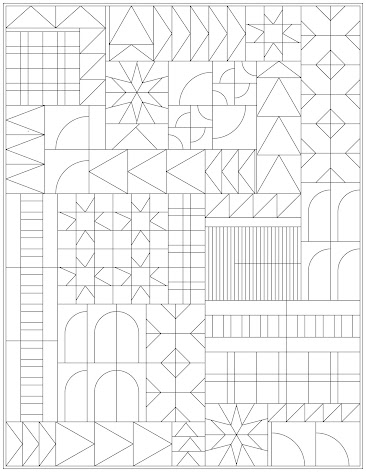Here we are, already at Month Six of the Big Fun Mystery Sew Along! And there’s still plenty of time to join in. We’ll have a few more months of blocks and techniques and design ideas, and then we’ll spend some time focusing on how to turn it all into a finished quilt.
This month is all about HSTs, or half-square triangles. Similar to Month Three, when our theme was flying geese, we’re looking at a variety of methods for making HSTs instead of focusing on a specific block. And (as promised!) we’re showing a couple of possible quilt layouts using the blocks and techniques we’ve covered so far.

If you haven’t started the Big Fun Mystery Sew Along yet and want to play along, feel free to jump in now and/or check out any of the past months’ instructions:
Month One: Curves
Month Two: Stripes
Month Three: Flying Geese
Month Four: Stars
Month Five: X and Plus Blocks
Share your work and your process on Facebook or Instagram with the hashtags #chicagomqgsewalong and #BFMSAL.
MONTH 6: Half-Square Triangles
HSTs are the building blocks of so many quilt and block designs. They could also make great fillers if you plan to turn your BFMSAL blocks into a sampler quilt, and they would make a lovely border for a medallion. You can make them one-at-a-time, or two-at-a-time (perhaps the classic, or most common, method). You can even make four (or eight!) at once. There’s a method for making them in strips and for using special papers or specialized rulers. I recently made blocks that involved a foundation paper piecing method to make eight HSTs at once with no trimming needed. It was very satisfying, but that method doesn’t lend itself to easy scaling as many other methods do.
Even if you already have a tried and true construction method, different quilts call for different methods. Sometimes you only need to make a couple of HSTs, or you want them to be scrappy instead of identical. In that case you’d want to generate less units at a time. If you’re making a huge quilt, though, or blocks with lots of HSTs in repeating colorways, then it might make sense to use a method that makes many units at once.
Ready to get started? We’ve gathered some tutorials and resources here:
Five Easy HST Tutorials from Blossom Hearts Quilts (Includes two-, four-, and eight-at-a-time, strip piecing, and using triangle papers.)
Modern Fundamentals: Half-Square Triangles by Yvonne Fuchs for the MQG* (A downloadable PDF that includes two-, four-, eight-, and one-at-a-time methods.)
*You need to be a Modern Quilt Guild member to view this article. If you’re a Chicago MQG member, then (lucky you!) you are an MQG member as well!
Use your HSTs to make an Ohio Star, a Bear Paw, this fun Modern Mountain block, or this Scrappy Sawtooth Star. Those blocks pictured above? I sewed two of them together, seams aligned, using the two-at-a-time HST method to make scrappy hour glass blocks for my BFMSAL quilt.

And, finally, here are some quilt layout ideas using blocks and techniques from Months One through Six of this sew along.
First, a medallion possibility. This specific configuration comes out to 88″x88″ and it’s just using blocks from the first six months! We encourage you to come up with your own configuration using your favorite BFMSAL blocks for the borders, but you are welcome to replicate this design (in part or in whole) if you wish. One tip that many of us learned when working on the guild’s Medallion Quilt Along of 2016 was to add filler strips in between each border to help square up the quilt, especially as the quilts grew bigger.

Then a sampler version — this one is about 48″x63″. Although you’re probably better off using your design wall (or floor or table) to try out your own configuration using the blocks you’ve made. I got a little carried away in Illustrator and realize now that there would be more than a couple of y-seams to deal with in this design. But hopefully you get the idea. I like grouping the same block to make a short strip or a larger square or rectangle, and also repeating elements in one or more different areas to draw your eye across the quilt. Flying geese (improv or otherwise), HSTs, and the plus block in varying sizes make good fillers for blank spaces. Or let those areas be negative space to allow the eye to rest and make a less “busy” design. There are endless possibilities!

Please reach out to Amy or Bill with any questions about the Big Fun Mystery Sew Along. We hope you’re enjoying the process!
